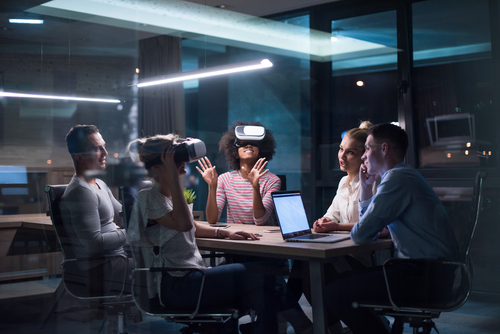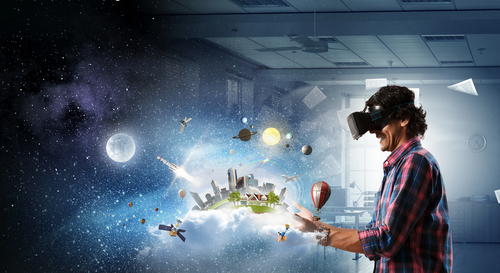April 25, 2021
Five Years of VR: A Look at VR’s Stunning Growth

While virtual reality (VR) has been present in our lives since the early 80s, it’s only in these last five years that VR has crystallized into a modern phenomenon, transforming how we perceive reality and play with our surrounding environment. But what exactly is VR, and what makes it so powerful?
Read on to find out how virtual reality has grown into the ultimate futuristic digital technology to pivot toward.
What is VR?
Virtual reality is a digital invention created to engage your senses and take you on an enticing, virtual world experience through advanced technology. The virtual reality event can be as small as a cockpit of an airplane, down to a whole virtual world. Whatever the environment you’re in, virtual reality systems aim to make it as immersive and realistic as possible.
How does virtual reality work?
Virtual reality operates by being hooked up to a special device like headsets, PlayStation, or goggles, placing users in a simulation viewed through a screen. The virtual reality systems hardware are made up of sensors connected to your device, with computer-generated imagery and content feeding you a digital 3D environment. VR tools are undeniably powerful, tapping into your senses of sight, hearing, and touch, prompting you to interact with high-quality images resembling reality.
Five years of VR experience
When three popular virtual reality hardware were introduced in 2016 — the Oculus Rift, the HTC Vive, and PSVR — sales underperformed. Consumers were hesitant to buy into the then-pricey products, and there was a consensus that the products were overhyped and didn’t take user functionality into consideration.
Today, the picture has significantly changed, with VR becoming more accepted, thanks to manufacturers constantly improving devices and content. Take Facebook’s Oculus Quest virtual reality headsets, for instance. The product is off to a strong start, offering exclusive games like Half-Life, with sales doubling in 2020 alone.
There’s no doubt that Facebook is quickly dominating the virtual reality arena with exciting new VR products, moving beyond just virtual reality headsets and gaming. In the pipeline, the social media giant is developing its Horizon platform, where people will be able to build and share an online world where they play games, hang out, or work together.
And it’s not just Facebook that’s reaping the benefits. The gaming industry leads in first-rate VR products and is manufacturing items at an unprecedented pace. The bottom line is, people will always be willing to splurge on epic entertainment experiences, with Sandbox VR being a good case in point.
Sandbox VR is a classic example of how far people will go to enjoy the ultimate VR experience. Gamers can go to real-world VR centers and use bodysuits to play five games, including one licensed from Star Trek, that let people battle it out in space or fight their way through a virtual zombie apocalypse.

VR’s growth rate
While VR has always been somewhat viewed as a technology holy grail, it recently elevated its status to a first-class technology to manufacture, with various companies — big and small — wanting a slice of success at developing virtual reality technology. Indeed, the latest statistics point toward a huge demand, both for consumers and industry players alike, with Grand View Research forecasting the market will approximately grow 18% per year from 2021 and 2028 to reach $69.60 billion by 2028.
If the predictions hold, the hype about virtual reality will only continue in the same vein, showcasing how market opportunities are ripe in the sector.
Advantages of virtual reality
Virtual reality has many benefits that industries could pivot toward in the coming decades. Here are four cool examples of how VR could be applied in our lives.
Training
In the aerospace industry, VR is used to train employees in dangerous environments, with pilots already using simulators in case they make a mistake. Meanwhile, doctors could use virtual reality to avoid costly medical mistakes at work, and firefighters could use VR as part of their training to face their first fire incident.
Treating medical conditions
Researchers are already talking about how virtual reality technology can treat mental health treatments, helping people overcome their phobias and fears head-on through simulations.
Video conferencing
Forget Zoom; VR has the potential to connect digital employees in online meetings and conferences. There will be real-time events, something like Facebook Live with VR. Rather than watching your colleague on screen, it would feel like you’re there in the room with them.
E-commerce
Shoppers could buy products in a virtual marketplace, checking out how a rug could look like in their own home without ever needing to step foot in a shop.
Future predictions

In a way, virtual reality technology is just getting started, with an expected increase in more sophisticated products and devices hitting our shelves soon.
Here are some projections of where VR is heading:
- Headsets to become more mainstream
- Interactions with VR will be available on smart wearables
- Headsets will look more fashionable, like sunglasses, for instance
- An increased presence of VR in social interactions
Virtual reality isn’t going anywhere
Yes, virtual reality is still in a nascent stage, but the technology has remarkable potential and can open up a world of new experiences and applications. Today, VR provides what consumers are looking for, and it has considerable potential to be integrated into our lives more seamlessly in the future. All in all, expectations remain high for VR, and it will only continue to grow from strength to strength.







